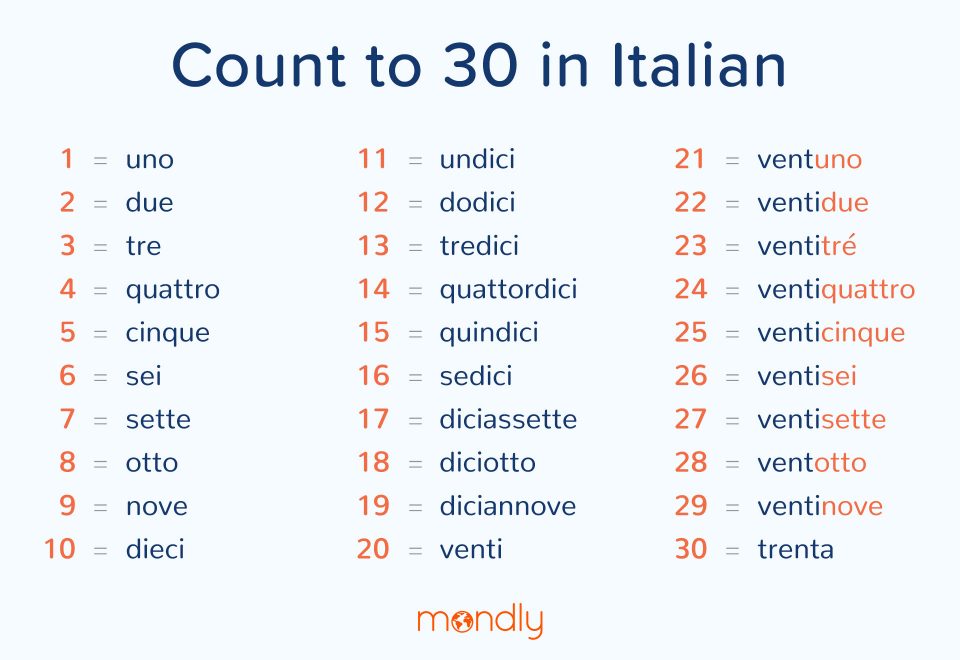Go Beyond “Ciao Bella”: 20+ Italian Slang Words & Expressions
Do you want Italians to take you as one of their own? Use these expressions. 🤌
From zero to cento, mille and beyond, let’s see how fast can you master the Italian numbers. It’s easier than you think!

Lucky for us, language learners, most languages use Arabic numerals (0, 1, 2, 3, 4, 5, 6, 7, 8, 9) in writing. The challenging parts are pronunciation and spelling. When you start learning Italian, you will, of course, need to learn numbers. Italian numbers are easy to remember and pronounce because they follow a simple and predictable pattern. Once you know the Italian numbers to 10, counting to 100 and even 1000 is easy.
There’s hardly a day that passes without using numbers. They’re essential to our day-to-day lives. From shopping to giving people your phone number and setting up a meeting at a certain time, numbers are probably one of the first lessons you should take in any language. So, let’s see how easy it is to count from zero to cento in Italiano.
To master the Italian numbers quickly, it’s essential to first learn how to count to 10. The numbers from 1 to 10 are important for two reasons: you will probably use them the most and they lay the foundations for any Italian number you can think of.
Here’s how to write and pronounce the Italian numbers 1-10:
1 – uno (oo-noh)
2 – due (doo-eh)
3 – tre (treh)
4 – quattro (kwah-troh)
5 – cinque (chin-kweh)
6 – sei (say)
7 – sette (seh-teh)
8 – otto (oh-toh)
9 – nove (noh-veh)
10 – dieci (dee-eh-cheh)
Don’t worry, we didn’t forget about 0. Zero is especially useful when exchanging phone numbers in Italian. “Zero” is zero in Italian and the “z” is pronounced “ds” or “ts” – dsee-roh.
Not sure you understood how to pronounce the Italian numbers to 10? Here’s a short video with crystal-clear audios recorded by a fluent Italian speaker so you can learn from the best:
Imagine this: you are on the famous Amalfi Coast. The weather is perfect. And let’s say you want to buy 12 slices of the yummiest Italian pizza you’ve ever seen: two slices for you and each one of your friends. The problem is you only have 10 fingers to sign to the lady at the counter. Wouldn’t it be easier if you knew some Italian expressions?
Now back to numbers: once you get to 20, Italian numbers are easy to build with what you already know and remember. However, the numbers from 11 to 19 are a bit irregular, so you’ll have to remember them by heart.
Here’s how to count to 20 in Italian:
11 – undici (oon-dee-chee)
12 – dodici (doh-dee-chee)
13 – tredici (treh-dee-chee)
14 – quattordici (kwah-tor-dee-chee)
15 – quindici (kween-dee-chee)
16 – sedici (seh-dee-chee)
17 – diciassette (dee-cha-set-teh)
18 – diciotto (dee-chee-otoh)
19 – diciannove (dee-chahn-noh-veh)
20 – venti (ven-tee)
As you can see, for 11 to 16, Italian numbers are formed following the pattern number + 10 (dieci). From 17 to 19, the order reverses: 10 (dieci) is followed by the number.
Let’s see some examples:
Essentially, Italian numbers are very similar to English numbers. Once you get to 20, you just put together the tens with the single numbers (units). The best part is that Italian doesn’t even require spaces or hyphens. For example, if you want to say 22 (“twenty-two”), in Italian you say venti (20) + due (2) = ventidue (22).
Let’s recap what you’ve learned so far and see how to count to 30 in Italian:

See how easy Italian numbers are? The only thing you have to remember is that the final vowel of the tens disappears when you add 1 (uno) or 8 (otto). Thus, you’ll say ventuno and not “ventiuno”. Additionally, number 3 (tre) gains an accent mark on the final vowel. For example, 33 will be trentatré and 83 will be ottantatré.
Except for 10 (dieci) and 20 (venti), all tens digits in Italian are based on their roots. Once you know all of them, you’ll know how to count to 100 – which is cento – in Italian.
10 – dieci (dee-eh-cheh)
20 – venti (ven-tee)
30 – trenta (tren-tah)
40 – quaranta (kwah-rahn-tah)
50 – cinquanta (cheen-kwanh-tha)
60 – sessanta (ses-sahn-tah)
70 – settanta (set-tahn-ta)
80 – ottanta (oht-tahn-ta)
90 – novanta (noh-vahn-tah)
100 – cento (chen-toh)
Let’s see some more examples to make sure you understood how Italian numbers work:
The same rules apply to bigger numbers as well. Add the suffix cento to the multiplier digit and here are your hundreds:
100 – cento
200 – duecento
300 – trecento
400 – quattrocento
500 – cinquecento
600 – seicento
700 – settecento
800 – ottocento
900 – novecento
1000 – mille
And now you also understood where grazie mille comes from. Literally meaning “a thousand thanks” or “a thousand thanks yous”, grazie mille means “thank you very much” in Italian.

Back to counting, from 100 and beyond, the bigger the number is, the longer its written form. Italian doesn’t isolate hundreds, tens and ones. They become one long word with no hyphens or spaces. For example:
If you want to go even further, thousands are formed by adding mille to the digit multiplier. The only difference is that while hundreds use cento every time, thousands use the plural mila.
1000 – mille
2000 – duemila
3000 – tremila
4000 – quattromila
5000 – cinquemila
6000 – seimila
7000 – settemila
8000 – ottomila
9000 – novemila
10,000 – diecimila
For example, to say 2345 in Italian, you say duemilatrecentoquarantacinque. At this point the written numbers become really big and could easily compete in the “longest word in the world” race.
Nevertheless, to talk about the bank accounts of some of the richest people in the world in Italian, you’ll need even bigger numbers:
And there you have it! Now you can call yourself an esperto (“expert”) in Italian numbers. Ciao!
Do you want to see the Italian numbers in action in real-life conversations? Get Mondly, the award-winning language learning app that will help you speak Italian as if you were Tuscany-born.
It can be really tricky to master the Italian way of speaking if you don’t actively live in Italy. But with Mondly, you’ll have access to a unique, fast and highly efficient learning method that allows you to learn Italian naturally with practical topics, authentic conversations and bite-sized Daily Lessons.
Start using Mondly for free on your computer or download the app and learn Italian fast anytime, anywhere.

Do you want Italians to take you as one of their own? Use these expressions. 🤌

Are you ready to become un italiano vero? 🤌

Here are multiple different ways to say "hello" in Italian. Because greetings should always be no. 1 on your list of priorities when traveling abroad.
italian language course